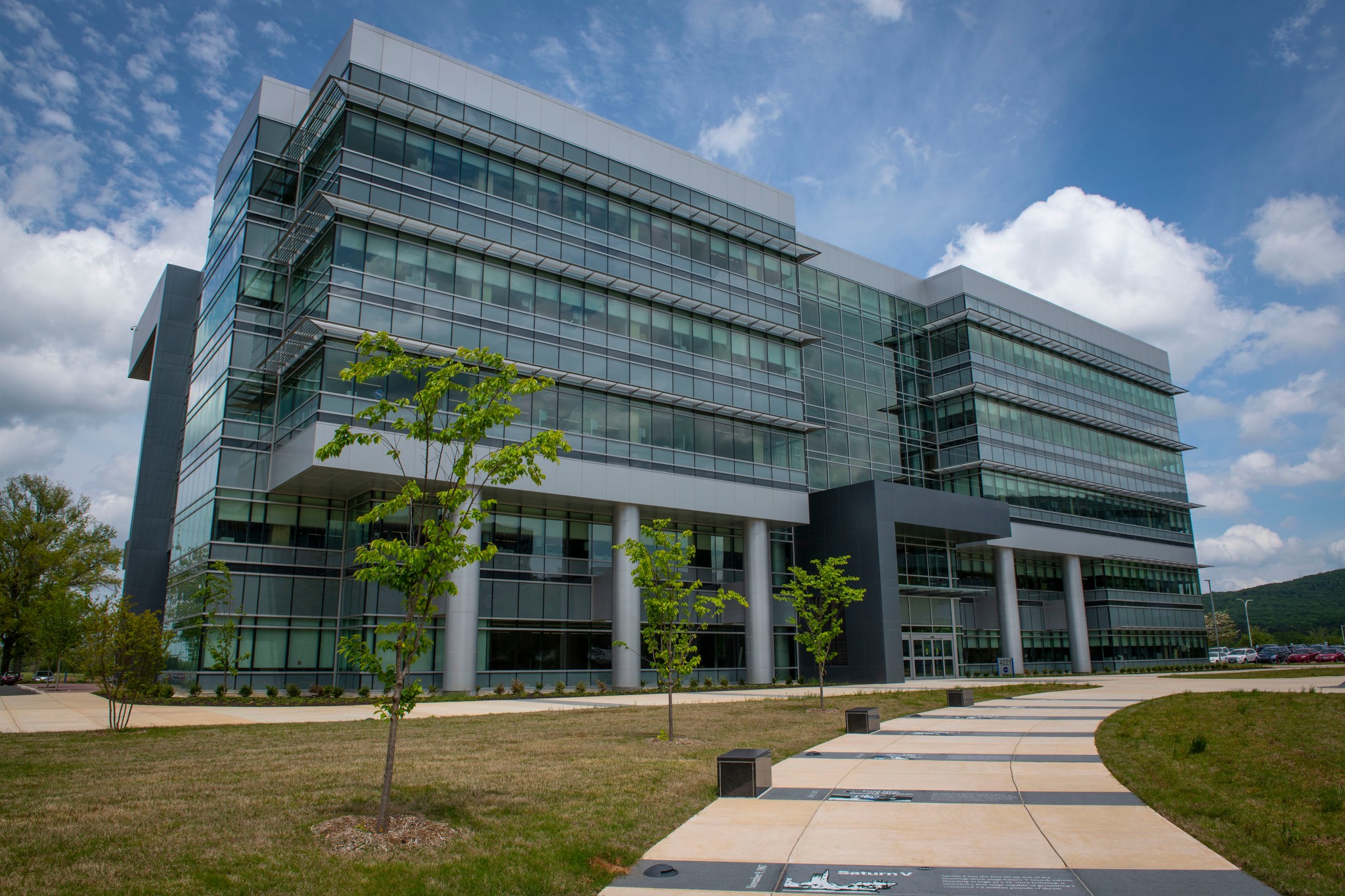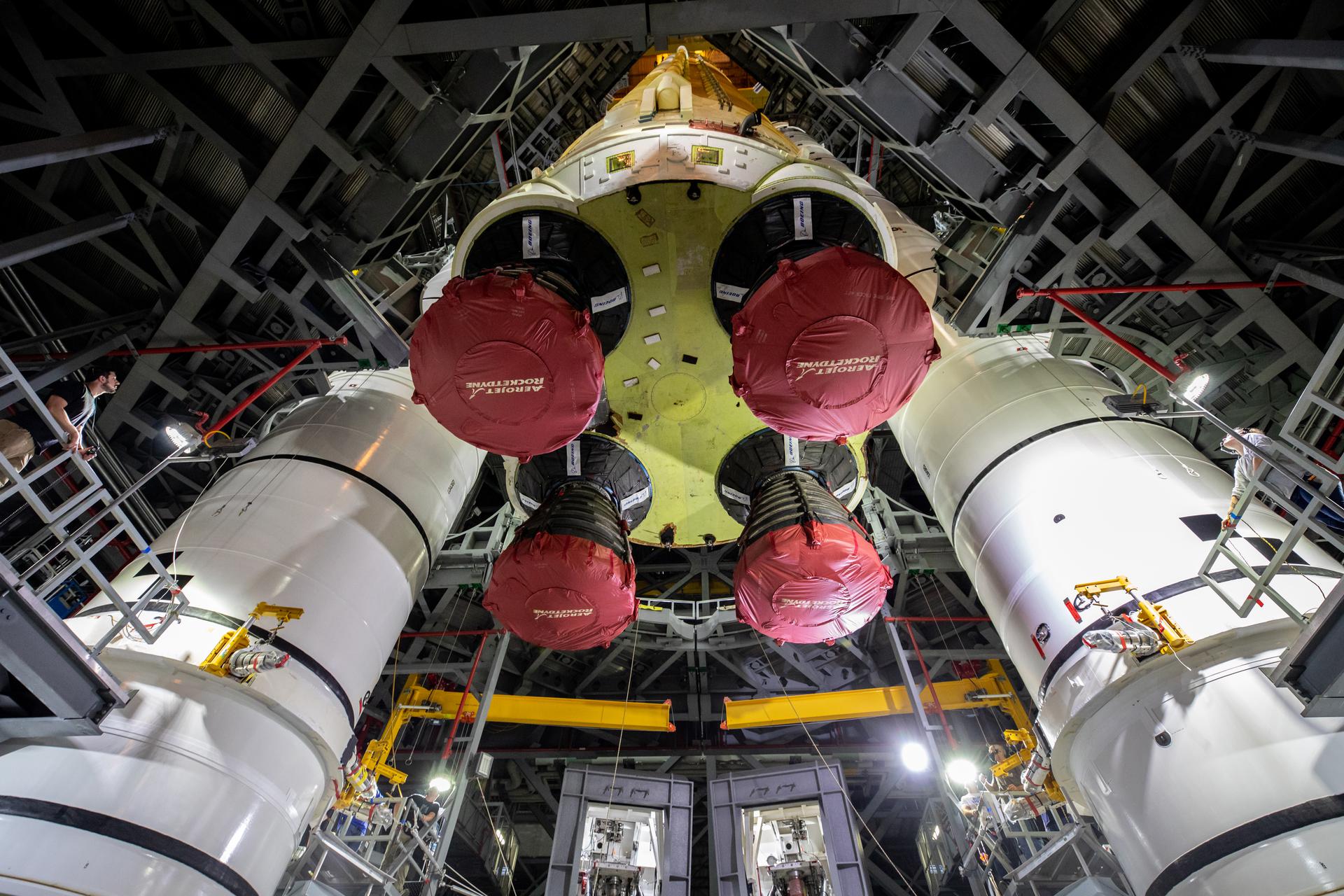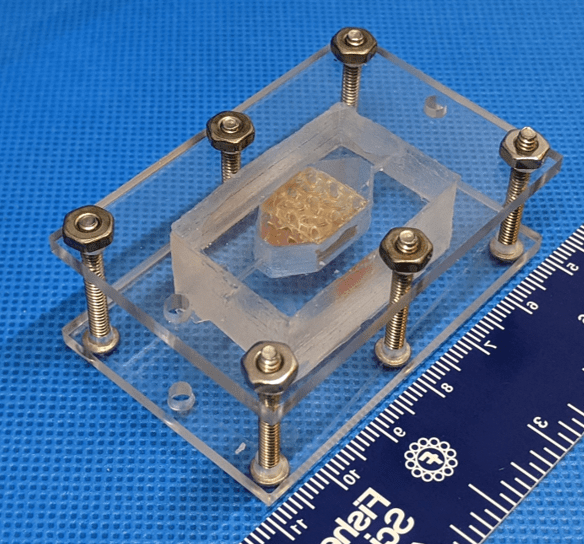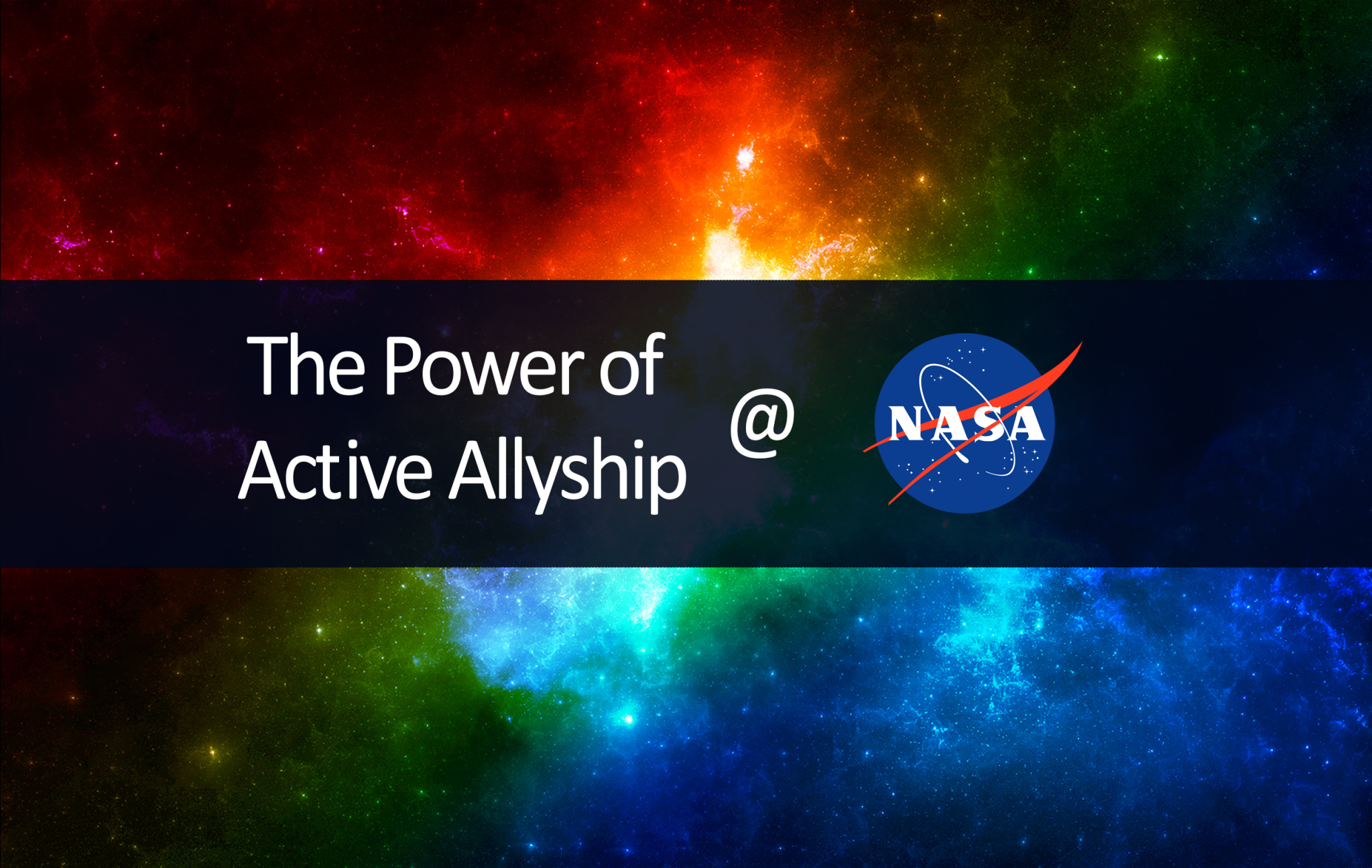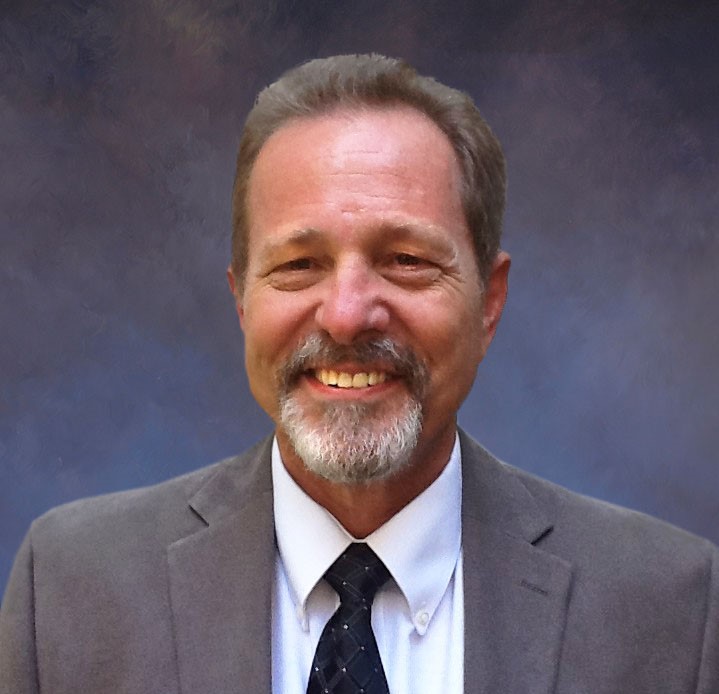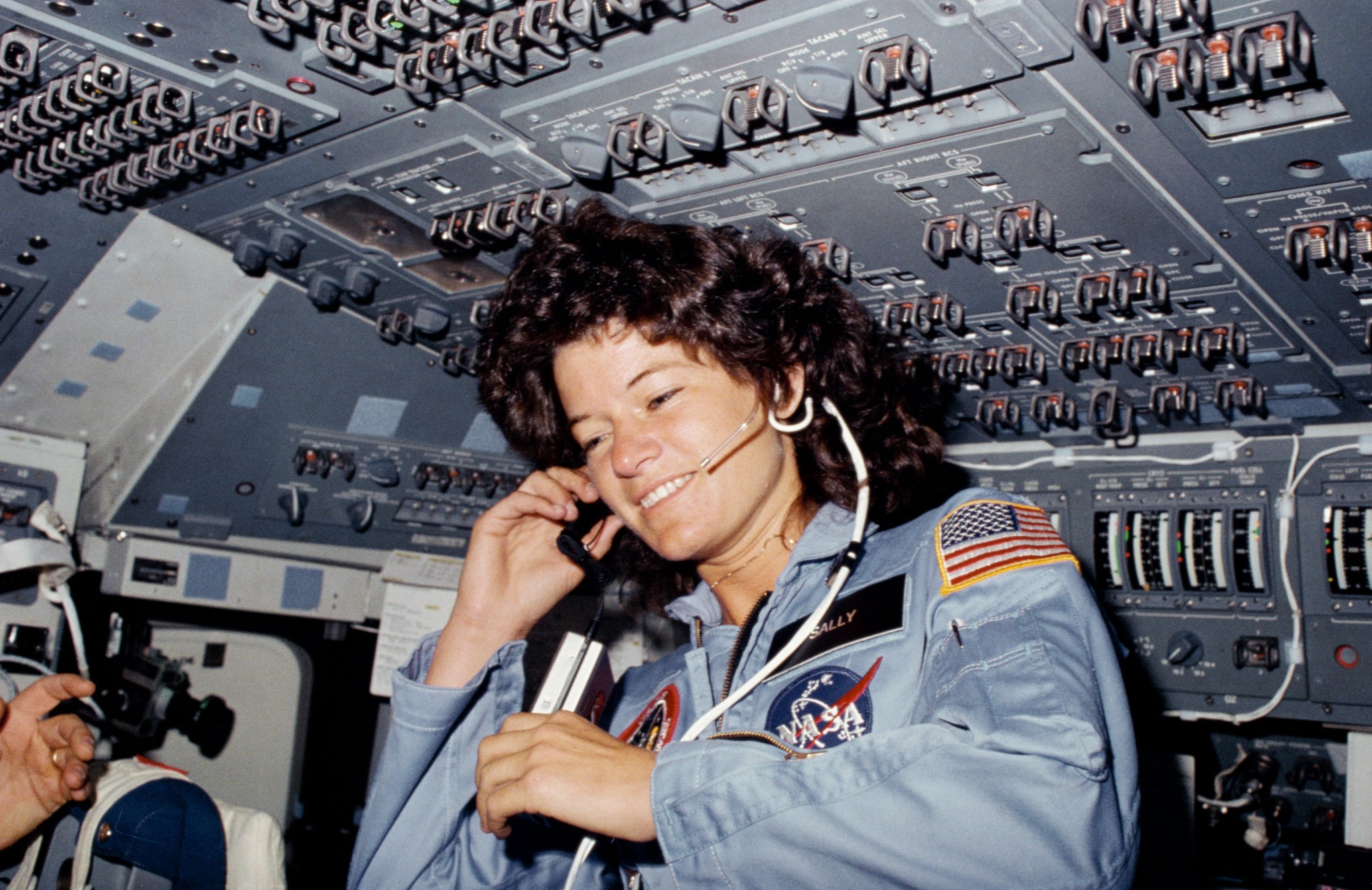A Force of Flexibility: Marshall Reimagines, Plans for Post-Pandemic Productivity
By Taylor Goodwin
As the world attempts to define “the new normal,” NASA’s Marshall Space Flight Center is carving out its version of what ordinary will look like once the COVID-19 pandemic has passed, joined with an agencywide Future of Work initiative.
Bill Marks, deputy director of Marshall’s Office of Center Operations, says he will never forget March 2020 – the beginning of an unforgettable year supporting the Marshall team through a global pandemic. Since then, Marshall transitioned from a traditional on-site work environment to majority teleworking in response to the pandemic. Now he and his team are envisioning an environment where telework is more common and team members work where and how they can be most productive.
The closing of Building 4200 has displaced all team members who previously occupied that space and prompted Marshall leaders and managers to reimagine work with different workspace realities. With some organizations and team members opting to adopt a majority-telework situation, Center Operations was able to make assessments for new areas for the displaced team members, eliminating the immediate need to build or rent new office spaces.
“Our mission is to develop and implement a plan to transform the pre-pandemic work environment where the vast majority of the workforce is on-site to a blended environment that expends flexible telework opportunities to the workforce,” Marks said, “while optimizing available on-site space to accommodate rapidly growing on-site missions and set conditions for future growth and agility.”
Even in a time of extreme adversity, the Marshall team continued to achieve mission milestones – including Space Launch System Green Run testing; Human Landing System development; the launches of the Commercial Crew Program’s Demo-2, Crew-1, and Crew-2 missions; and advancements in the Mars Ascent Vehicle, Solar Cruiser, and Imaging X-Ray Polarimetry Explorer.
“When you consider the tragedy of the pandemic, you realize that no one was exempt from that,” said Larry Mack, deputy director of Marshall’s Office of Human Resources. “Although our people have been challenged by the pandemic, they have still delivered on the mission each day. We’ll be leveraging the experiences of the past year while planning the move forward and widening the aperture of flexibility afforded to our team.”
Under current agency guidelines, telework is voluntary and supervisor-approved. This guidance will remain as team members begin to return to site over time, as safety permits. However, in the future NASA is planning for team members to have more options in how they work, with additional guidance anticipated later this summer. The NASA Shared Services Center invited further input with a short survey that was available May 24 to June 4 to better understand employee ideas, opinions, and preferences for telework and on-site work after the pandemic.
To accommodate the workforce displaced from Building 4200, Marshall managers assessed whether team members will be on-site for more than 50% of the pay period, and if so, the team member was assigned permanent office space on-site. If the team member plans to telework for less than 50% of the pay period, they will have the opportunity to utilize a “hotel space” – a work space available for majority-teleworking team members to reserve when they need to work at the center. Each organization will have designated hoteling spaces close to the organization’s permanent seats in order to maintain cohesiveness with the team. “This is another opportunity for us to provide flexibility to the workforce,” Mack said. The logistics of reserving the space when an individual needs to be on-site will be as simple as reserving a conference room for a meeting.
“Hoteling will support team members in allowing flexibility to work where and how they are most productive, as well as provide opportunities to reduce Marshall’s environmental footprint and better utilize space at the center,” Marks said. “This could include posturing for future expansion, trimmed operations, and reduced maintenance costs.”
“When we are able to safely return,” Marks said, “the center will be much how people remember it – with a few big changes in work.” Building 4221 will house the Director’s Office and be the main administrative building. It sits at the north end of a new greenway being created by the demolition of Building 4201. This central greenway will continue south with Building 4619 at the foot. Also, to maximize power efficiency, all steam pipes will be removed, and the center will transition to natural gas usage.
Looking further ahead, Marshall has also made the strategic decision to prioritize the addition of a new science and avionics laboratory and Marshall is revising its master plan to include future space for meetings, trainings, and an auditorium.
“NASA helps change the human condition,” Mack said. “Marshall is widely known for our ‘secret sauce,’ and I believe our culture is the main ingredient. We want to do everything we can to maintain that in this new blended world.” Center leadership is focused on ensuring that team members have all the tools, resources, support, and information necessary to be successful, wherever they may be. “A well-balanced work life includes opportunities for engagement and to be innovative whether you are a virtual worker or on-site,” Mack said.
Marks says that he hopes to see the Marshall team strike a new, healthier work-life balance as it enters this new era. “In a post-pandemic world, the blended workforce is even more beneficial. When we can interface with the world and our loved ones in a safe capacity, we will have an entirely different experience.”
“We have asked our people to pivot on a dime,” Mack said. “They have shown resilience, agility, receptivity, compassion, and empathy – a concentrated effort to make a difference in our agency, our mission, and each other. We are thrilled to see how Marshall will progress with this new force of flexibility.”
Goodwin, a Media Fusion employee, supports Marshall’s Office of Strategic Analysis & Communications.
Backbone of NASA’s Moon Rocket Joins Boosters for Artemis I Mission
The core stage of the Space Launch System rocket for NASA’s Artemis I mission has been placed on the mobile launcher in between the twin solid rocket boosters inside the Vehicle Assembly Building at NASA’s Kennedy Space Center. The boosters attach at the engine and intertank sections of the core stage. Serving as the backbone of the rocket, the core stage supports the weight of the payload, upper stage, and crew vehicle, as well as carrying the thrust of its four engines and two five-segment solid rocket boosters. After the core stage arrived on April 27, engineers with Exploration Ground Systems and contractor Jacobs brought the core stage into the Vehicle Assembly Building for processing work and then lifted it into place with one of the five overhead cranes in the facility. Watch a time-lapse video of the lifting and stacking here. Once the core stage is stacked alongside the boosters, the launch vehicle stage adapter – which connects the core stage to the interim cryogenic propulsion stage – will be stacked atop the core stage and quickly followed by the interim cryogenic propulsion stage. Artemis I will be an uncrewed test of the Orion spacecraft and SLS rocket as an integrated system ahead of crewed flights to the Moon. Under the Artemis program, NASA aims to land the first woman and first person of color on the Moon in 2024 and establish sustainable lunar exploration by the end of the decade. (NASA/Cory Huston)
Marshall Engineers Send Next-Generation Air Filtration Hardware to Wallops
By Rick Smith
New air filtration technology developed, built, and tested at NASA’s Marshall Space Flight Center will soon be bound for the International Space Station – where it will demonstrate advanced life support system capabilities that could help future explorers on the Moon and Mars breathe easier.
The new hardware, known as the 4-Bed Carbon Dioxide Scrubber, was shipped June 9 from Marshall to NASA’s Wallops Flight Facility, where it will be carried to orbit by the Cygnus NG-16 commercial resupply mission.

The scrubber is one of two next-generation Environmental Control and Life Support System technologies to be tested on the space station for one year, helping recycle and regenerate most of the air and water necessary to sustain its crew – and proving advanced regenerative technology solutions for upcoming Artemis missions to the Moon and eventual human excursions to Mars.
The other technology, the Thermal Amine Scrubber, uses actively heated and cooled amine beds – water purification technology used around the world – to remove carbon dioxide from the air. It was delivered to the station in early 2021.
Once installed, the new carbon dioxide scrubber will use commercial adsorbent materials to retain water vapor while filtering carbon dioxide out of the space station’s airflow. Adsorption is the use of beaded porous materials, known as “molecular sieves,” to separate metabolic carbon dioxide to be discarded or recycled.
The space station’s current Carbon Dioxide Removal Assembly has conducted this task since early 2001. The 4-Bed Carbon Dioxide Scrubber is a design iteration of the current assembly, incorporating numerous engineering and technology changes to improve durability and maintainability. These upgrades are crucial for future exploration missions beyond Earth orbit.
Once its demonstration year is over and its capabilities proven, the new scrubber unit will be integrated into the station’s closed-loop recycling system for a minimum of three years to further demonstrate its viability for long-duration exploration missions and to contribute to station crew life support capabilities.
As many as 100 Marshall engineers, materials researchers, and safety personnel, plus sensor, filtration, and pump hardware specialists at NASA’s Johnson Space Center, had a hand in the design, fabrication, and testing of the new hardware unit, said Donnie McCaghren, project manager for the 4-bed CO2 scrubber at Marshall.
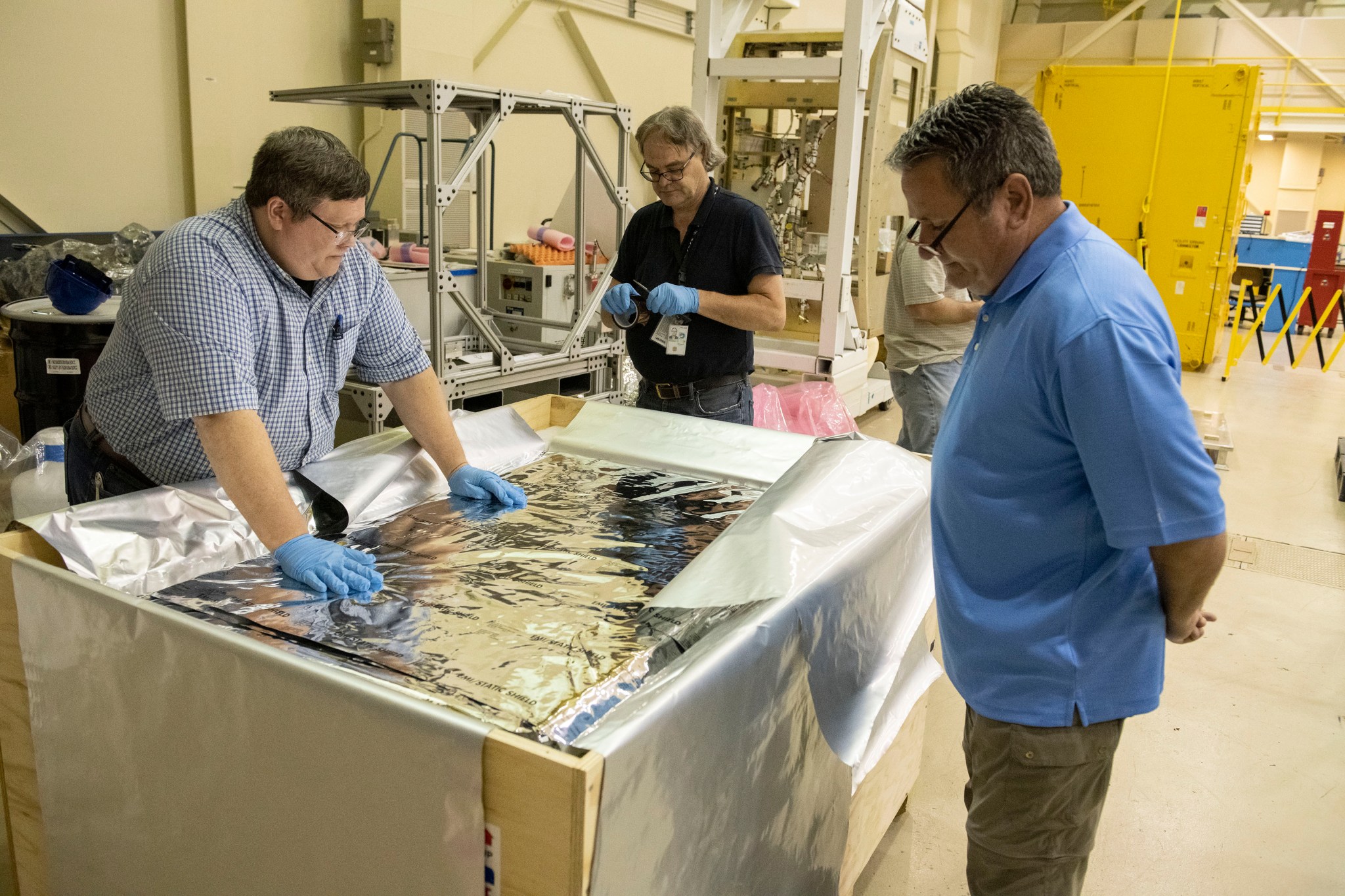
“Our primary goal was increasing efficiency and maintainability, to ensure fully functioning, longer-lasting hardware on orbit with less need for crew maintenance,” McCaghren said. “We reduced the scrubber’s power consumption, improved the thermal stability and lifespan of the adsorbent materials, and added replaceable filters, more durable valves, and protective covers for the valve motors.”
The team also upgraded the adsorbent bed internal heating units and redesigned the beds to be circular rather than rectangular, which improves performance and reliability. They also used Marshall’s state-of-the-art 3D printers to prototype and test key components – a capability that could, in years to come, enable crews in space to print replacement parts as needed, rather than wait for resupply flights from Earth.
The new scrubber unit also will test a first-of-its-kind, magnetic bearing air blower to push the air through its adsorption beds. The blower was developed by a commercial provider for NASA to replace an obsolete blower technology.
The new hardware is roughly the size of a small refrigerator and weighs approximately 450 pounds. Its operation and technology demonstration will be overseen in orbit by mission controllers at Johnson, with continuing contributions by Marshall space station hardware engineers.
The Cygnus NG-16 spacecraft, built by Northrop Grumman of Falls Church, Virginia, is scheduled to lift off later this summer.
Smith, a Manufacturing Technical Solutions employee, supports Marshall’s Office of Strategic Analysis & Communications.
Teams Engineer Complex Human Tissues, Win Top Prizes in NASA Challenge
By Amanda M. Adams
Teams of scientists from the Wake Forest Institute for Regenerative Medicine in Winston-Salem, North Carolina, have won first and second place in NASA’s Vascular Tissue Challenge. The prize competition aims to accelerate tissue engineering innovations to benefit people on Earth today and space explorers in the future.
Competing as teams Winston and WFIRM, each used a different approach to create lab-grown human liver tissues that were strong enough to survive and function in ways similar to those inside the human body. The teams each used a varied 3D printing technique to construct a cube-shaped tissue about 1 centimeter thick and capable of functioning for 30 days in the lab.
Team Winston, the first team to complete its trial under the challenge rules, will receive $300,000 and has the opportunity to advance its research aboard the International Space Station U.S. National Laboratory. Team WFIRM will receive the second-place prize of $100,000. Two teams affiliated with other organizations continue to vie for third place and the remaining $100,000.
The research may help enable the growth and long-term survival of thick three-dimensional tissues for research and therapeutic applications, and eventually organ bandages and replacements. In the near term, they could accelerate pharmaceutical testing and disease modeling. And while more advancements are needed to make it a reality, artificial organs developed from a patient’s own cells would change lives, reduce transplant waitlists, and help end the organ shortage.
“I cannot overstate what an impressive accomplishment this is. When NASA started this challenge in 2016, we weren’t sure there would be a winner,” said Jim Reuter, NASA associate administrator for the Space Technology Mission Directorate. “It will be exceptional to hear about the first artificial organ transplant one day and think this novel NASA challenge might have played a small role in making it happen.”
Tissues in the body rely on blood vessels to supply cells with nutrients and oxygen and remove metabolic waste – a process known as perfusion. As it isn’t easy to recreate this process in engineered tissue, NASA asked teams to develop and test strategies for making tissues with functional artificial blood vessels.
The winning teams used 3D printing technologies to create gel-like molds, or scaffolds, with a network of channels designed to maintain sufficient oxygen and nutrient levels to keep the constructed tissues alive for their 30-day trials, as specified in the challenge rules. Winston and WFIRM used different 3D-printed designs and different materials to produce live tissues that harbored cell types found in human livers.
“The value of an artificial tissue depends entirely on how well it mimics what happens in the body,” said Lynn Harper, challenge administrator at NASA’s Ames Research Center. “The requirements are precise and vary from organ to organ, making the task extremely exacting and complex. The research resulting from this NASA challenge represents a benchmark, a well-documented foundation to build the next advance upon.”
In space, the models could be used to study how radiation exposure affects the human body, document organ function in microgravity, and develop strategies to minimize damage to healthy cells while living or working in space. Microgravity also may facilitate the creation of even larger and more complex engineered tissues that look and function more like those in the human body, compared to tissues constructed on Earth.
The space station’s U.S. National Laboratory, which is managed by the Center for the Advancement of Science in Space, will work with team Winston to adapt the winning Earth-based strategy for space. If the research makes it to the station, the combination of improved vasculature and microgravity could yield the next set of advances for tissue engineering on Earth and biomanufacturing in space.
“NASA brings value to our country in various and sometimes unexpected ways,” Reuter said. “To see multiple teams succeed in getting a complex 3D tissue composed of multiple human cells to survive and function after a month is amazing and a promising steppingstone for future tissue engineering studies.”
The Vascular Tissue Challenge is led by Ames and is part of Centennial Challenges, based at NASA’s Marshall Space Flight Center. Centennial Challenges is a part of the Prizes, Challenges, and Crowdsourcing program within the Space Technology Mission Directorate. The Methuselah Foundation’s New Organ Alliance executed the competition and recruited the nine-member judging panel. The nonprofit organization focuses on regenerative medicine research and development.
Adams, an LSINC Inc. employee, supports Marshall’s Office of Strategic Analysis & Communications.
Hinode Shares X-ray Observations of June 10 ‘Ring of Fire’ Solar Eclipse
People around the Northern Hemisphere had the chance to experience an annular or partial eclipse of the Sun on June 10, while the international Hinode satellite captured its own views from its orbit around Earth. Because of its position in orbit, Hinode’s X-ray Telescope observed the Moon passing in front of the Sun four times, with two passes almost directly in front of the star, creating a similar “ring of fire” effect as seen in the path of the annular eclipse on Earth. The telescope observes the solar atmosphere at millions of degrees, including the ultra-hot material in active regions above sunspots. Several bright active regions are visible as the Sun’s activity begins to trend upward in its roughly 11-year solar cycle. Hinode is a joint endeavor by the Japan Aerospace Exploration Agency, the National Astronomical Observatory of Japan, the European Space Agency, the United Kingdom Space Agency, and NASA. NASA’s Marshall Space Flight Center manages Hinode’s science operations for the agency. (NASA/JAXA/SAO/Montana State University)
NASA, Marshall to Celebrate Pride Month with Allyship-focused Events
Each June, NASA celebrates Pride Month with events and programs across the agency. This year, leaders from multiple NASA centers and Headquarters are participating in a joint panel discussion: “The Power of Active Allyship.” The program will include a welcome from NASA Administrator Sen. Bill Nelson, a panel discussion and videos about the importance of allyship. All are invited to attend the virtual program, which will air on NASA TV at 1 p.m. CST.
Marshall’s Office of Diversity and Equal Opportunity will also host a lunch and learn for team members June 23 from 11 a.m.-noon CST, via Teams. The guest speaker will be Mark Moore, director of Development and Marketing at Thrive Alabama, a north Alabama affordable primary healthcare provider that emphasizes understanding, compassion, and respect to the LGBTQ+ community.
At Marshall, the Office of Diversity and Equal Opportunity champions NASA’s commitment to a culture of diversity, inclusion, and unity. “Pride Month is a time to celebrate and support our LGBTQ+ community, while acknowledging the struggles many have faced,” said Emily Naderi, an Equal Employment Opportunity specialist in the office who also coordinates Marshall’s Out and Allied employee resource group. “Marshall is a space where all should feel welcome and valued, and we will continue to strive for unity, knowing that we are a stronger and better workforce when we come together.”
On June 1, Nelson addressed the NASA workforce, reinforcing the agency’s dedication to cultivating a representative and inclusive workforce. “As we celebrate LGBTQ+ Pride Month in June, we recognize another opportunity for each of us at NASA to show our commitment to a culture of diversity, equality, mutual respect, and inclusion,” he wrote. “This commitment helps us succeed as an agency, and what we do makes the world a better place.”
Dr. Andrew Molthan, deputy branch chief of Marshall’s Earth Science Branch and project scientist for its Satellite Needs Working Group effort, will take part in the agency program, sharing his thoughts on the importance of allyship. “The support of straight allies throughout Marshall was critical to establishing and lending support to our Out and Allied team,” he said. “As a gay employee at NASA, I know that many of my LGBTQ+ colleagues have stories to share about the beneficial support of a strong ally. Still, many more would benefit from the outreach and support of their colleagues, and in turn, we can all serve as allies to others. Our LGBTQ+ community – and all Marshall team members – should feel that they are heard, safe, respected, and appreciated.”
Marshall’s offices of Human Resources and Diversity and Equal Opportunity are committed to diversity, unity, and cultivating a well-rounded and representative workforce. Programs such as the BRIDGE – Blueprint to Reinforce Inclusivity and Diversity to Gain Equity – Champions and employee resource groups are just some of the initiatives created to support these goals. The BRIDGE Champions distribute information on equal opportunity, equity, diversity, and inclusiveness to the entire center, using a network of select Marshall senior-level employees. Employee resource groups help plan and implement observance month activities, and are open to all employees to participate. For more information about joining Marshall’s Out and Allied group, email emily.s.naderi@nasa.gov. Visit the offices of Diversity and Equal Opportunity and Human Resources to learn more about resources and upcoming events.
‘Doing Business with NASA’ Event Coaches, Connects Industry with NASA
On June 17, the Small Business Office at NASA’s Marshall Space Flight Center will co-host a virtual industry event, “Doing Business with NASA,” with The Catalyst Center for Business & Entrepreneurship of Huntsville from 8:30 a.m. to noon. The event connects small and large businesses with NASA counterpoints to provide information on how to do business with Marshall and the agency. NASA and the Catalyst have hosted this event annually since 2017.
The event will include presentations from Marshall’s Office of Procurement, as well as updates on acquisition and agency product service lines from Marshall. Other topics will include a Marshall Small Business Program update, NASA Mentor-Protégé Program update, and Small Business Innovation Research/Small Business Technology Transfer Program update.
To learn more about doing business with Marshall, please visit here. For more details about the event and how to register, visit here or contact Leigh Christian at leigh.christian@catalystcenter.org.
Michael Wetmore, NASA Veteran, Retired Jacobs Engineering General Manager, to Deliver Virtual Tech Talk
Michael Wetmore, who spent two decades at NASA’s Kennedy Space Center before working with Jacobs Engineering as general manager of several NASA contracts, will give a presentation via Webex at 11:30 a.m. June 17, as part of the Mission Success is in Our Hands virtual lecture series. Wetmore will share his experiences working in a diverse array of high-risk technical environments during his career and challenge audiences to continuously find ways to improve safety culture. The Mission Success Is in Our Hands initiative is a campaign led by the Safety and Mission Assurance Directorate at NASA’s Marshall Space Flight Center and partner Jacobs Engineering of Huntsville that promotes and strengthens Marshall’s focus on mission, hardware, and crew safety. (NASA)
Cast Your Vote in NASA’s Artemis I Moonikin Challenge
As NASA prepares for the upcoming Artemis I mission, the first integrated test flight of the agency’s Space Launch System rocket and Orion spacecraft, the public can help name one purposeful passenger aboard Orion as part of the Name the Artemis Moonikin Challenge. The Artemis I “Moonikin” is a manikin, or anatomical human model, that will be used to gather data on the vibrations and accelerations during the Artemis I mission to the Moon to help teams prepare for future crewed Artemis flights. Beginning June 16, the public can vote for their favorite Moonikin name as part of the tournament style voting on Twitter, Facebook, and Instagram. NASA will announce the winning name June 29. For more on the Moonikin name contenders, click here. (NASA)
Juno Captures Images of Ganymede, Highlighted on ‘This Week @NASA’
NASA’s Juno mission sent back images after its June 7 flyby of Jupiter’s moon Ganymede and is featured in “This Week @NASA,” a weekly video program broadcast on NASA-TV and posted online.
The Juno images show remarkable surface detail, including craters, distinct areas of dark and bright terrain, and features possibly linked to tectonic faults. The flyby is expected to yield insights into the moon’s composition and makeup, including measurements of its radiation environment that could benefit future missions to the Jovian system.
Juno is part of the Science Mission Directorate’s New Frontiers Program, managed by NASA’s Marshall Space Flight Center.
View this and previous episodes at “This Week @NASA” or on NASA’s YouTube page.
This Week in NASA History: Launch of STS-7, 1st US Woman in Space – June 18, 1983
This week in 1983, space shuttle Challenger, mission STS-7, launched on a six-day mission to deploy two communications satellites, one for Canada and one for Indonesia. This was the first time the shuttle flew with a crew of five and the first time a U.S. woman was in space. Here, Sally Ride is seen on the flight deck of Challenger. Today, NASA’s Marshall Space Flight Center is playing a vital role in the Artemis program by developing the Space Launch System, the backbone of NASA’s exploration plans and the only rocket capable of sending humans to the Moon and Mars. The NASA History Program is responsible for generating, disseminating, and preserving NASA’s remarkable history and providing a comprehensive understanding of the institutional, cultural, social, political, economic, technological, and scientific aspects of NASA’s activities in aeronautics and space. For more pictures like this one and to connect to NASA’s history, visit the Marshall History Program’s webpage. (NASA)
























